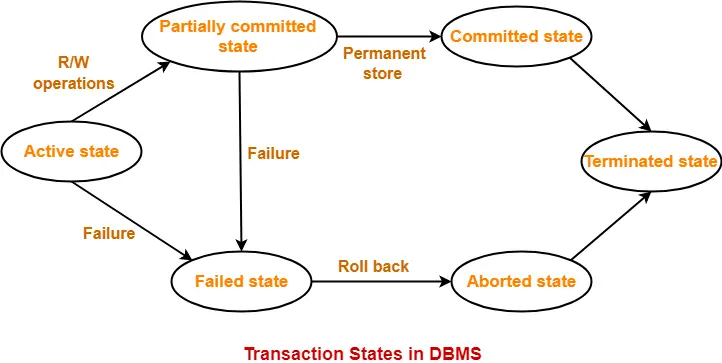Transaction in DBMS-
“Transaction is a set of operations which are all logically related.”
OR
“Transaction is a single logical unit of work formed by a set of operations.”
Operations in Transaction-
The main operations in a transaction are-
- Read Operation
- Write Operation
1. Read Operation-
- Read operation reads the data from the database and then stores it in the buffer in main memory.
- For example- Read(A) instruction will read the value of A from the database and will store it in the buffer in main memory.
2. Write Operation-
- Write operation writes the updated data value back to the database from the buffer.
- For example- Write(A) will write the updated value of A from the buffer to the database.
Transaction States-
A transaction goes through many different states throughout its life cycle.
These states are called as transaction states.
Transaction states are as follows-
- Active state
- Partially committed state
- Committed state
- Failed state
- Aborted state
- Terminated state

1. Active State-
- This is the first state in the life cycle of a transaction.
- A transaction is called in an active state as long as its instructions are getting executed.
- All the changes made by the transaction now are stored in the buffer in main memory.
2. Partially Committed State-
- After the last instruction of transaction has executed, it enters into a partially committed state.
- After entering this state, the transaction is considered to be partially committed.
- It is not considered fully committed because all the changes made by the transaction are still stored in the buffer in main memory.
3. Committed State-
- After all the changes made by the transaction have been successfully stored into the database, it enters into a committed state.
- Now, the transaction is considered to be fully committed.
NOTE-
- After a transaction has entered the committed state, it is not possible to roll back the transaction.
- In other words, it is not possible to undo the changes that has been made by the transaction.
- This is because the system is updated into a new consistent state.
- The only way to undo the changes is by carrying out another transaction called as compensating transaction that performs the reverse operations.
4. Failed State-
- When a transaction is getting executed in the active state or partially committed state and some failure occurs due to which it becomes impossible to continue the execution, it enters into a failed state.
5. Aborted State-
- After the transaction has failed and entered into a failed state, all the changes made by it have to be undone.
- To undo the changes made by the transaction, it becomes necessary to roll back the transaction.
- After the transaction has rolled back completely, it enters into an aborted state.
6. Terminated State-
- This is the last state in the life cycle of a transaction.
- After entering the committed state or aborted state, the transaction finally enters into a terminated state where its life cycle finally comes to an end.
Next Article- ACID Properties of Transaction
Get more notes and other study material of Database Management System (DBMS).
Watch video lectures by visiting our YouTube channel LearnVidFun.
Summary

Article Name
Transaction States in DBMS
Description
Transaction in DBMS is a set of logically related operations. Transaction states in DBMS are the states through which a transaction goes throughout its lifetime. Transaction states are- Active state, Partially committed state, Committed state, Failed state, Aborted state, Terminated state.
Author
Akshay Singhal
Publisher Name
Gate Vidyalay
Publisher Logo
